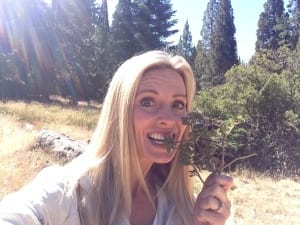Adding variety to your diet might be closer than you think. It’s often a simple discovery of learning what is new and different that is growing wild in your garden or in nearby fields. A common known weed that usually grows in flowerbeds is now getting the attention of nutritionists and health experts alike. Purslane (Portulaca oleracea) is a little weedy-looking succulent that you might have growing wild in your lawn or flower garden. It’s a low-growing, pulpy leafed plant that blooms tiny yellow flowers. It can look quite ugly in garden beds and it tends to spread widely and quickly after it takes root.
My husband and I were recently on vacation in California hiking through the Sequoia National Forest, where the incredible and magnificent giant sequoias reside. Some are as mature as 2,500-3,000 years old. The oldest known sequoia has a base 132 feet around. I became an official “tree-hugger” with that one. We felt like tiny ants as we stood next to them. It’s crazy to think that they were here even before Jesus. Boy, if those trees could talk I bet they could share some phenomenal stories.
The hikes we took were fun but intense. We met a kind man in the Kings Canyon area and he introduced us to puslane. I had heard of it and had seen it, but never knew of all its fabulous benefits…energy is one of them! We gladly took the plant and ate it along our hike when we needed a little boost. It did wonders and it had great taste (in my opinion). Don’t worry, we did research before we started nibbling on this random weed. I’m blonde, but a smart one! 🙂
While purslane may have been new to us, it’s not new to the world of weeds.
As I waded through all the weedy information on the Internet and through my Naturopath books, I found that purslane, the thick-leaved weed actually has several great health benefits. It’s also known as “cat’s tongue or pigweed,” and is low in cholesterol, a great source of Omega-3 fatty acids, beta-carotene, fiber, antioxidants, Vitamin C, and other vitamins and minerals. It’s touted to have five times the Omega-3 fatty acids as a more popular leafy salad variety…Spinach!
Antioxidants and Omega-3 fatty acids help to prevent cancer. Thus, people know purslane as a cancer-preventing herb. The stems, leaves, and even the flower buds are all edible. It’s a healthy additive to most dishes because of its high nutritional content, and because it is also low in fat and high in protein.
So where do we find such great power-packed nutrition? Not having seen it readily available in the local market, the best place would be to research your health food store or better yet…your own backyard. It’s sold in seeds, too, and you can grow it yourself in an herb garden if you desire. It’s a low-maintenance, hearty perennial that will not only benefit your garden with its sustainability but will flourish even in the most poor, dry soils. So, if you don’t have a “green thumb” you’re in luck…it will grow easily!
How do you use it? It can be used in fresh creations such as salad, stir-fried mix, steamed, or eaten raw like spinach. You can even toss it in your soups and stews! You can use purslane in cooking to thicken sauces. It has a great flavor and a crunchy texture. The weed doesn’t go limp and holds its shape when cooked, unlike most other leafy greens such as spinach. Many people often overlook purslane. It not only brings variety, crunch, and texture but also citrus and peppery flavors to different dishes. You can eat it raw in salads, sautéed with other greens, or combined with meats and fish to add a little tang. While most gardeners consider wild purslane to be a weed, this flavorful plant makes its way to upscale restaurant menus as well as home kitchens.
Give this weed a chance and let me know your thoughts. Share your comment below.





